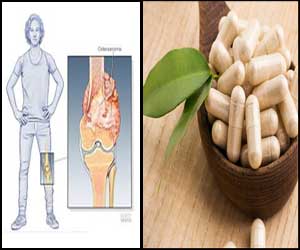- Home
- Editorial
- News
- Practice Guidelines
- Anesthesiology Guidelines
- Cancer Guidelines
- Cardiac Sciences Guidelines
- Critical Care Guidelines
- Dentistry Guidelines
- Dermatology Guidelines
- Diabetes and Endo Guidelines
- Diagnostics Guidelines
- ENT Guidelines
- Featured Practice Guidelines
- Gastroenterology Guidelines
- Geriatrics Guidelines
- Medicine Guidelines
- Nephrology Guidelines
- Neurosciences Guidelines
- Obs and Gynae Guidelines
- Ophthalmology Guidelines
- Orthopaedics Guidelines
- Paediatrics Guidelines
- Psychiatry Guidelines
- Pulmonology Guidelines
- Radiology Guidelines
- Surgery Guidelines
- Urology Guidelines
Withaferin-A: extract from Ashwagandha shows anticancer activity for osteosarcoma, finds a Phase-1 trial

Withaferin-A extracted from Ashwagandha in patients with advanced stage, high-grade osteosarcoma shows anticancer activity and good safety profile, revealed the findings of phase 1 trial. The phase-1 clinical trial was publshed in the Journal of Ayurveda and Integrative Medicine.
Ashwagandha (Withania Somnifera) is one of the most important herbs in Ayurveda, a form of alternative medicine based on Indian principles of natural healing. It has been used for over 3,000 years to relieve stress, increase energy levels and improve concentration. In the Ayurveda system of medicine, Ashwagandha is noted for its sedative and life-prolonging properties. Extracts from different parts of ashwagandha have been evaluated for various biological activities, such as cholinesterase inhibition, anti-inflammatory properties via cyclooxygenase-2 enzyme inhibition from leaf extracts, antibacterial properties and sex hormone deficiency regulation in rats with diabetes. The isolation and identification of several withanolides with anti-glycation and antipyretic activities from Withania has also been reported. The isolation and identification of several withanolides with anti-glycation and antipyretic activities from Ashwagandha has been reported in prior studies.
Withaferin- A (WA) is a therapeutically active withanolide reported to be present in roots and leaves of the plant. In several preclinical studies, it has shown significant anticancer activity.WA has been shown to prevent and cure urethane-induced lung tumors in mice, and also inhibit the growth of transplanted sarcoma in mice.
To assess the activity of the extract against osteosarcoma the authors planned a phase I dose escalation study using the classical 3 + 3 design (C33D). Dose escalation cohorts comprised of 72, 108, 144 and 216 mg of WA administered in two to four divided doses per day. Three patients were enrolled in each cohort and the last patient was observed for at least 30 days for any dose-limiting toxicity before progressing to a higher cohort. Pharmacokinetic studies were performed using High-Performance Liquid Chromatography (HPLC) technique with sensitivity up to 50 ng/ml. Safety evaluation including clinical examination, detailed history of adverse events, Liver Function Tests, Renal Function Tests, and complete blood counts were performed at each visit. WA was administered daily till progression. Common Terminology Criteria for Adverse Events (CTCAE) version 3.0 was used for grading adverse events.
Key findings
- The formulation was well tolerated by patients up to a dose of 4800 mg, equivalent to 216 mg of WA per day, without any dose-limiting toxicity. This was the highest dose that could be administered with reasonable tolerability and patient compliance since patients in the highest dose cohort (216 mg) were receiving a regimen of 4 capsules of WA TID.
- No dose-limiting toxicity (DLTs) were observed even at the highest dose indicating that higher doses may be tried in patients, but the total dose is limited by the number of capsules a patient can reasonably consume in a day.
- Elevation of liver enzymes (5/11) and skin rash (2/11) was the most common adverse events. Other adverse effects include fatigue, fever, edema, and diarrhea (one each).
- None of the patients had detectable levels of WA in circulation.
The authors concluded that the formulation was well tolerated. However, WA appears to have low oral bioavailability. Further studies with improved formulations are warranted.
For further reference, click on the link
https://doi.org/10.1016/j.jaim.2018.12.008

Disclaimer: This site is primarily intended for healthcare professionals. Any content/information on this website does not replace the advice of medical and/or health professionals and should not be construed as medical/diagnostic advice/endorsement or prescription. Use of this site is subject to our terms of use, privacy policy, advertisement policy. © 2020 Minerva Medical Treatment Pvt Ltd